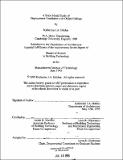| dc.contributor.advisor | Leslie K. Norford, Leon R. Glicksman. | en_US |
| dc.contributor.author | Holden, Katherine J. A. (Katherine Joan Adrienne) | en_US |
| dc.contributor.other | Massachusetts Institute of Technology. Dept. of Architecture. | en_US |
| dc.date.accessioned | 2011-11-18T20:52:39Z | |
| dc.date.available | 2011-11-18T20:52:39Z | |
| dc.date.copyright | 1995 | en_US |
| dc.date.issued | 1995 | en_US |
| dc.identifier.uri | http://hdl.handle.net/1721.1/67148 | |
| dc.description | Thesis (M.S.)--Massachusetts Institute of Technology, Dept. of Architecture, 1995. | en_US |
| dc.description | Includes bibliographical references (p. 81-84). | en_US |
| dc.description.abstract | Displacement ventilation is a form of air-conditioning which provides good air quality and some energy savings. The air quality is better than for a conventional mixed ventilation system. The maximum amount of cooling that displacement ventilation can provide whilst maintaining a comfortable space is between 25 and 40 W/m2. Chilled ceilings can be added to increase the cooling capacity of the system. A scale model study was carried out to determine comfort levels at different conditions, to establish maximum cooling loads and to observe flow patterns in a typical office room with displacement ventilation and a chilled ceiling. Refrigerant R114 was used as the scaling fluid and an existing test box was used as the model room. Heat sources were simulated using electric resistances in aluminum enclosures. A gas and a water circuit were built to supply ventilation and cooling to the room. Flow visualization was carried out by injecting refrigerant laden with ammonium chloride smoke into the supply point. The smoke was lit by a spotlight shone between two pieces of cardboard and images were taken using a video camera. The results showed that for displacement ventilation alone, the temperature distribution was within stringent comfort levels for heat loads up to 25 W/m2 with an air change rate of 7.5. When a chilled ceiling was added, up to 40 W/m2 could be cooled within comfort levels. The refrigerant was radiatively absorbing, so the radiation cooling from the ceiling was reduced. Therefore, this maximum cooling load is probably an underestimate. Some displacement occurred at low levels for this cooling load, which indicated good air quality, but it was below the breathing zone. At higher loads, the flow appeared to be mixed. Therefore, the benefit of enhanced air quality with displacement ventilation was lost when a chilled ceiling was added. The use of a scale model allowed the study of ventilation systems without building a full scale room. It was of limited use for this study because the heat transfer by radiation could not be modelled correctly with this refrigerant. Further experiments could be carried out with lower supply air rates. The experiments could be improved by ensuring more accurate measurement of the water and gas flow rates and temperatures, reducing heat losses. Flow visualization could be improved by injecting smoke at different points within the room and by using a stronger, more focused plane of light. The apparatus could be used for future work on heat transfer that does not involve a significant amount of radiation. It is recommended that a more leak-tight box with a greater height is built and a more environmentally friendly refrigerant is used. | en_US |
| dc.description.statementofresponsibility | by Katherine J.A. Holden. | en_US |
| dc.format.extent | 84 p. | en_US |
| dc.language.iso | eng | en_US |
| dc.publisher | Massachusetts Institute of Technology | en_US |
| dc.rights | M.I.T. theses are protected by
copyright. They may be viewed from this source for any purpose, but
reproduction or distribution in any format is prohibited without written
permission. See provided URL for inquiries about permission. | en_US |
| dc.rights.uri | http://dspace.mit.edu/handle/1721.1/7582 | en_US |
| dc.subject | Architecture. | en_US |
| dc.title | A scale model study of displacement ventilation with chilled ceilings | en_US |
| dc.type | Thesis | en_US |
| dc.description.degree | M.S. | en_US |
| dc.contributor.department | Massachusetts Institute of Technology. Department of Architecture | |
| dc.identifier.oclc | 33337027 | en_US |
